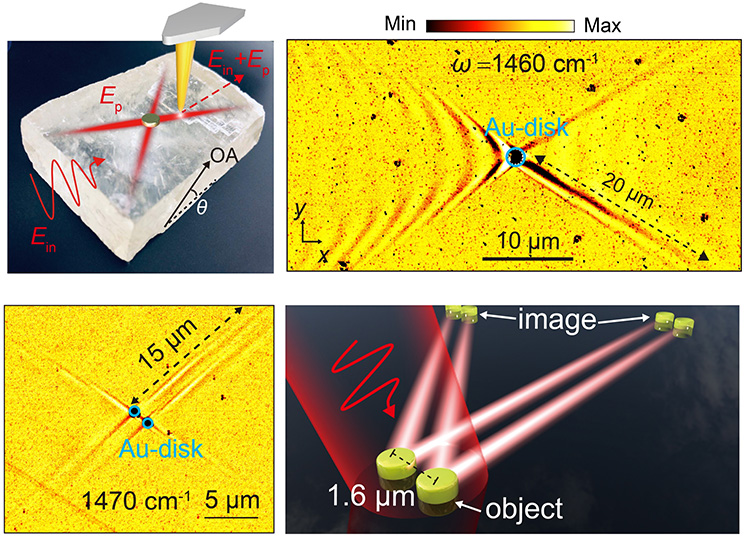 Top left: Schematic of s-SNOM imaging to map ghost polaritons. Top right: Experimentally imaged ray-like, long-distance polariton propagation at the calcite surface. Polaritons are launched by a gold nanodisk. Bottom left: Polariton ray launched by two gold disks with edge-to-edge distance of 650 nm. Bottom right: Schematic of in-plane hyperlens based on ghost polaritons. [Adapted from W. Ma et al. Nature 596, 362 (2021)]
Top left: Schematic of s-SNOM imaging to map ghost polaritons. Top right: Experimentally imaged ray-like, long-distance polariton propagation at the calcite surface. Polaritons are launched by a gold nanodisk. Bottom left: Polariton ray launched by two gold disks with edge-to-edge distance of 650 nm. Bottom right: Schematic of in-plane hyperlens based on ghost polaritons. [Adapted from W. Ma et al. Nature 596, 362 (2021)]
Polaritons—quasiparticles formed by photons strongly coupled with material oscillations—are of great interest for modern optical technologies.1 Their investigation has opened new vistas for photonics and materials research. Recent advances have focused on emerging low-dimensional van der Waals (vdW) nanomaterials, for their exotic optical features, such as extreme anisotropic responses that are associated with hyperbolic polaritons that enable extreme light–matter interactions.2,3 The demanding nanofabrication requirements for revealing these features, however, have hindered the integration of these materials into large-scale practical technologies.
We recently revealed a new form of hyperbolic polaritons propagating at the interface of calcite with air.4 Calcite is a very common polar crystal, known for its optical birefringence—a property used by seafaring Viking explorers in ancient times to reveal the sun’s position even on cloudy days.5 Calcite’s infrared optical properties, however, have been rarely explored.
We have unveiled the existence of a peculiar form of hyperbolic phonon polaritons (HPhPs) in calcite, sustained by the interaction of light with infrared-active phonons associated with ionic lattice vibrations. At a dielectric–calcite interface, we have found that “ghost” hyperbolic polaritons can emerge. So far, HPhPs have been unveiled either in volume or surface form, with fields that either propagate or decay, respectively, inside the bulk of the crystal. Our ghost HPhPs are bounded at the calcite-air interface—yet they show a nonzero phase evolution in the calcite bulk, which enables more resilience to loss.
Using scattering-type scanning near-field optical microscopy (s-SNOM), we mapped these highly confined polaritons featuring hyperbolic ray-like and long-distance propagation (up to 20 µm) at room temperature. Based on these features, we demonstrated sub-diffractive imaging and asymmetric launching of HPhPs. We have also shown that these ghost polaritons can be tuned by mechanically polishing the calcite surface and thereby continuously reconfiguring the optical axis with respect to the interface with air.
Our work reveals a new polaritonic platform without the need for exotic vdW media—one that allows easy fabrication and the possibility of mass-production within mature processes. We believe it could be ideally suited for infrared and terahertz sensing, signal processing, energy control and other technologies.
Researchers
Guangwei Hu and Cheng-Wei Qiu, National University of Singapore, Singapore
Weiliang Ma, Runkun Chen, Xinliang Zhang and Peining Li, Huazhong University of Science and Technology, China
Debo Hu and Qing Dai, National Center for Nanoscience and Technology, Beijing, China,
Andrea Alù, CUNY Advanced Science Research Center, New York, NY, USA
References
1. D.N. Basov et al. Science 354, aag1992 (2016).
2. W. Ma et al. Nature 562, 557 (2018).
3. G. Hu et al. Nature 582, 109 (2020).
4. W. Ma et al. Nature 596, 362 (2021).
5. J. Marchant, Nature (2011), doi: 10.1038/news.2011.58.
